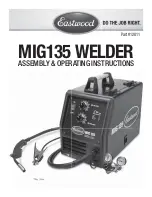
- 23 -
DYNA TIG 201AC/DC Operating Manual
7.0 BASIC ARC WELDING GUIDE
7.01 Electrode polarity
Stick electrodes are generally connected to the “+” terminal and the work lend to the “-“ terminal but if in
doubt consult the electrode manufacturers literature.
7.02 Effects of stick welding various materials
High tensile and alloy steels
The two most prominent effects of welding these steels are the formation of a hardened zone in the weld
area, if suitable precautions are not taken, the occurrence in this zone of under-bead cracks. Hardened zone
and under-bead cracks in the weld area may be reduced by using the correct electrodes, preheating, using
higher current settings, using larger electrodes size, short runs for larger electrode deposits or tempering in a
furnace.
Manganese steels
The effect on manganese steel slow of cooling from high temperature is to embrittle it. For this reason it
is absolutely essential to keep manganese steel cool during welding by quenching after each weld or skip
welding to distribute the heat.
Cast iron
Most types of cast iron, expect white iron, are weldable. White iron, because of its extreme brittleness,
generally cracks when attempts are made to weld it. Trouble may also be experienced when welding
white-heart malleable, due to the porosity caused by gas held in this type of iron.
Copper and alloys
The most important factor is the high rate of heat conductivity of copper, so making preheating of heavy
sections necessary to give proper fusion of weld and base metal.
Types of Electrodes
Arc welding electrodes are classified into a number of groups depending on their applications. There are
a great number of electrodes used for specialized industrial purposes, which are not of particular interest for
everyday general work. These include some low hydrogen types for high tensile steel, cellulose types for
welding large diameter pipes, etc. The range of electrodes dealt with in this publication will cover the vast
majority of applications likely to be encountered; are all easy to use and all will work on even the most basic of
welding machines.
Metals being joined
Electrode
Comments
mild steel
6013
Ideal electrodes for all general purpose work. Features
include out standing operator appeal, easy arc starting and
low spatter.
mild steel
7014
All positional electrodes for use on mild and galvanized
steel furniture, plates, fences, gates, pipes and tanks etc.
Especially suitable for vertical-down welding.
cast iron
nickel 99%
Suitable for joining all cast irons except white cast iron.
stainless steel
318L-16
High corrosion resistance. Ideal for dairy work, etc. On
stainless steels.
copper, bronze, brass etc.
bronze
5.7ERCUSI-A
Easy to use electrode for marine fittings, water taps and
valves, water trough float arms, etc. Also for joining copper
to steel and for bronze overlays on steel shafts.
high alloy steels, dissimilar
metals, crack resistance, all
hard-to-weld jobs
312-16
It will weld most problematical jobs such as springs, shafts,
broken joins mild steel to stainless and alloy steels. Not
suitable for Aluminum.
Table 17 Types of Electrodes













































